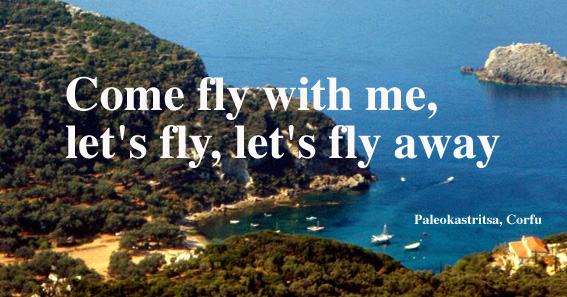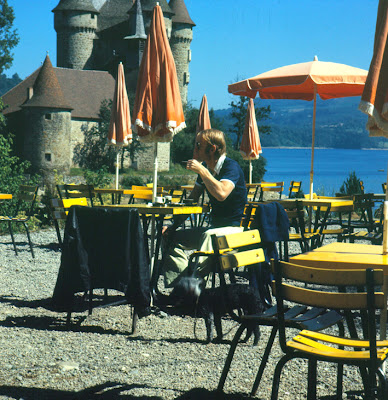Auvergne Pastorale
We parked the car under a tree and sat munching cold chicken as someone inside the house played a piano. The music drifted out the window into the stillness, as we sat and listened - our picnic dappled with light and shade and serenaded by Chopin
 Chopin farmhouse, Auvergne country
Chopin farmhouse, Auvergne countryWe had driven all day - up, up, up into the Pyrenees. Rich pastures on either side of the road stretched towards the mountains and small Spanish villages, framed by trees and brightened by wildflowers, nestled in the folds of hills. Ahead of us lay tiny Andorra, and beyond Andorra, the peaks of the Pyrenees and the pass across the mountains into France. Somehow, I missed the signpost to Andorra. It's easy enough to do for there's so much to see here. So we skirted this postage-stamp enclave, driving through increasing mountain mist to the Spanish frontier of Puigcerda. The sky was black and the rain pelting down when we reached the French frontier, Bourg Madame. After cafe au lait in a little roadside place, we set off towards the long, winding pass through the mountains and down to Ax-Les-Thermes. The drive was incredibly difficult, for a heavy cloud sat on top of the Pyrenees, so we drove slowly, in and out of thick mist until we reached the lower foothills. As we approached Ax-Le-Thermes, the sun finally broke through the clouds, and the rain-slicked road glistened in the sunshine.
A trip through the southwestern part of France, from the Pyrenees to the Massif Central, is a surprising journey; the region was largely undiscovered by travellers until the 1950s and even today its tranquillity is undisturbed by the tourist hordes. They follow better-known routes - to the Loire country, for example, or southeast to the Mediterranean coast. I say surprising, because most first-time visitors are unprepared for the astonishing beauty of this part of France. With its rolling green hills, timbered valleys, deep gorges and winding rivers, the country is alternatively cultivated and wild - and its ancient towns and villages enhance the landscape with architecture that is memorable in its stone-built simplicity.
The southwest will reward the visitor with culinary delights, too. This is truffle country, famed for pate de fois gras, cassoulet from Toulouse, excellent cheeses from the Pyrenees, delectable melons and peaches - and menus which the average restaurant prepares and serves with tender loving care.
I made the trip from Spain, but the journey can be made in the opposite direction, starting in Lyon and ending in Toulouse or (if you'd like the trip over the mountains) in Barcelona. Allow two or three days, longer if you'd like to linger awhile. Prices are lower here than they are in the country's capital - overnight accommodation and a good meal with wine in the attractive little towns and villages en route cost about half what you'd expect to pay.
From Ax-les-Thermes, a Pyrenean spa town (and centre for great excursions to the nearby mountains) we drove on to Foix, on the Ariege River, a quiet town of narrow streets, elegant old riverside hotels and a splendid old castle, built back in 1012 by the Vicompte de Carcassonne for his son who became Compte de Foix.
Travelling further on, we found a comfortable and inexpensive inn near Toulouse in which to spend the night. Dinner was a memorable welcome to France: pate, tender Canard a l'Orange and Entre-Deux-Mers, a dry local white from vineyards which flourish between two rivers, the Dordogne and the Garonne. Next day, I bypassed Toulouse, preferring to spend the time in the countryside and in the smaller villages. The day was perfect, the kind of weather that begs for a picnic. Just beyond Toulouse, I took on supplies. When you are travelling this road, the N20 (which becomes the N89) between Toulouse and the Mont Dore area in the Massif Central, I recommend you do the same. Those long crisp loaves of French bread, sweet butter, delicacies from the local charcuterie and a good white or red wine to wash it all down-your trip will take on a extra dimension, and it's a great way to economize.
We were now rolling through the Auvergne countryside, a landscape of patchwork farmlands and woods of oak and pine with old stone farmhouses and barns pale gold in the sunshine. We drove through Montauban, a Huguenot stronghold in the early 17th century and today an important crossroads and marketing centre for the area's fruit and vegetable products. Much of the town is built, like Toulouse, of pink brick. See, if you can, the Place Nationale, which is crowded with stalls on market day. Visit, as well, the former episcopal palace, now the Ingres Museum; in the l4th century basement is The Chamber of the Black Prince.
Cahors, 61 km up the N20, is an interesting town. Situated on the River Lot (a medieval bridge, the Pont de Valentre spans it), Cahors has been fought over on many occasions, particularly in the 12th century, when it fell into the hands of the English King Henry II after his marriage to Eleanor of Aquitaine. Later, the town was sacked by the Huguenots during the Religious Wars. There are many fine old buildings worth visiting, including the Cathedral of St-Etienne, the university College of Pellegri and the massive Tour du Chateau du Roi, now a prison.
Cahors is deep in truffle country. Truffles grow near the roots of oaks, which are plentiful here, and local pigs are used to snuffle them out. In the hillside village of Labenque, about 16 km from the town, farmers bring the truffles they've found to the truffle dealers. The exchange takes place at precisely 2pm every Tuesday from November through March. These earthy delicacies eventually find their way to Paris, where the deluxe food shops sell them for more than $350 a pound.
Between Cahors and Brive, the next major town, we decided to look for a picnic place. The day was hot, the sky a brilliant blue and the breeze was fragrant with the smell of fresh-mown hay. On impulse, I turned off the main road and drove a short way along a little rural road. In a few minutes, we came to a cluster of stone buildings. The farmhouse was biscuit-coloured, accented with bright red wooden shutters and a dark green climbing vine. Opposite the house was a barn of honey stone, its roof green with moss. We parked the car under a tree and sat munching cold chicken as someone inside the house played a piano. The music drifted out the window into the stillness, as we sat and listened - our picnic dappled with light and shade and serenaded by Chopin. It was one of those perfect moments you hope for on a holiday, impossible to plan, unrepeatable. Whenever I think of the Auvergne, my mind goes back to that magic place.
Later that afternoon, beyond Brive and Tulle, a handsome old town squeezed into a narrow valley - and after a rural roller-coaster of a ride which announced the proximity of the Massif Central ranges - we again relied on instinct and turned the car off the road into a little village, called Rochefort-Montagne. Set in the shadow of a high hill - and an equally dominant concrete highway bridge - Rochefort-Montagne huddles in a kind of canyon. It's on the road map, but barely. I doubt if one traveller in a hundred ever swings off the road to look at it, let alone stay overnight, as we did.
We parked the car on one of the cobbled streets and walked to the small central square, finding there a comfortable hotel (and budget prices). After exploring the town and climbing the hill, under mossy oaks, for a view from above, we had a leisurely meal in a nearby restaurant and retired. The room overlooked a millstream, which gurgled us to sleep.
The following morning, we awoke to discover a whole market had been set up in the little square below-dozens of stalls, filled with everything from huge ripe peaches - arranged with Tiffany elegance - to crates of ducks, geese and rabbits. It had all happened so quietly, we were not even aware of it. The village and its square had been transformed into a bustling picture postcard, a Brueghel scene framed by our hotel-room window.
The village of Le Mont-Dore, 1,800 metres up and a ski centre in winter is a few kilometres from Bort-les-Orgues via the N122. We stopped a little further on in another of those picnic places you dream about, high atop a pasture-covered mountain, with a magnificent view in all directions, within earshot of cowbells and decorated with wild violets. This, then, is undiscovered France, washed by the Dordogne, infinitely romantic. The road leads on, through St Nectaire with its casino, spa and placid swans, to Ambert, St Antheme and, at last, the gourmet city of Lyon. Whether you start your journey here, or conclude it, as we did, you'll have many happy memories to take home with you.









